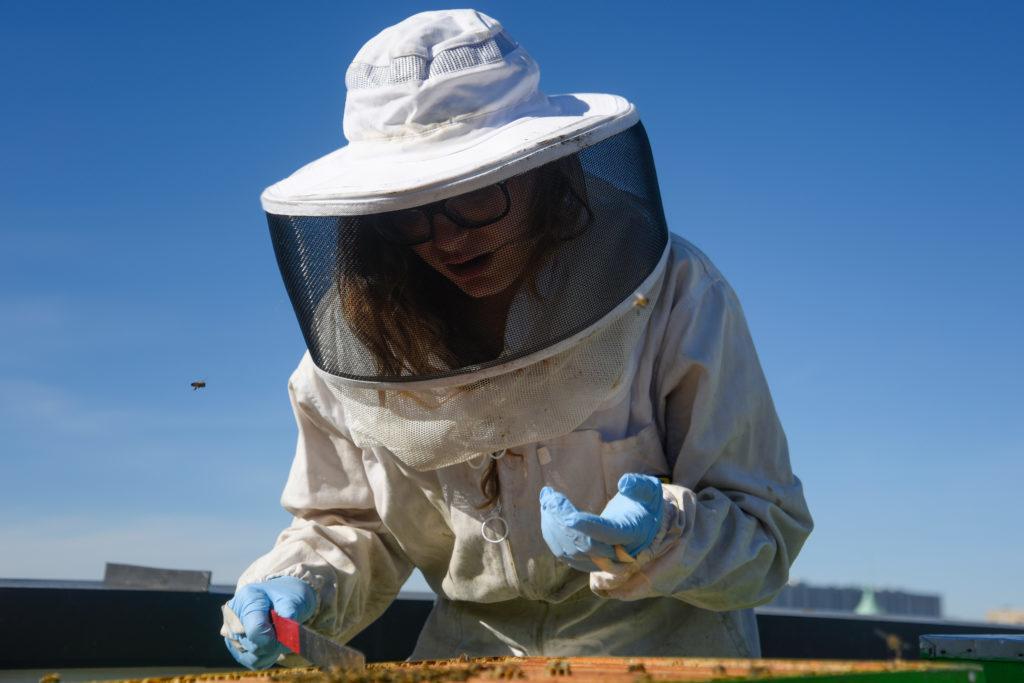The sound of buzzing atop Lisner Hall might seem fainter this fall after two of GW’s hives collapsed.
Researchers are puzzled after two of the 12 hives that are part of GW Buzz’s apiary – a collection of beehives on the roof Lisner Hall – collapsed last month, killing several hundred bees. Beekeepers and experts said a number of hazards could have led to the hives’ downfall, including harmful pesticides in the surrounding area and parasites that target honeybees.
Students and faculty who run the hives – to conduct research and collect honey for local restaurants – said they hadn’t pinpointed an exact cause for the collapse, but they were surprised that it wiped out one of their strongest and oldest hives.
Kayla Schwartz, a junior and head beekeeper for GW Buzz, the undergraduate honeybee research and beekeeping group, said in the past few months the hives had also seen queen bees die before the end of their expected lifespan, impacting the health of the hive. She said the apiary’s struggles caused bees to produce a lower amount of honey than usual this year.
“One of our hives that had lasted since 2015, it’s all gone, which is very upsetting to me,” she said. “It could be due to pesticides, pests, an array of things that could have happened.”
[gwh_image id=”1043927″ credit=”Madeleine Cook | Staff Photographer” align=”none” size=”embedded-img”][/gwh_image]
Schwartz said some colonies of bees suffer from infestations of varroa mites, a parasite equivalent to a tick the size of a baseball glove biting a human. She said her research with GW Buzz has dealt extensively with treating bees for these parasites, looking at how the mites will latch onto the bees, draining their nutrients and sucking out their energy.
“All I can say is that we have two hives that collapsed and I could not tell why,” she said. “But we definitely did have varroa over the summer because I did research on them.”
Hartmut Doebel, an assistant professor of biology and faculty advisor for GW Buzz, said hive collapses follow a national trend of bees struggling to maintain successful colonies. The population of bees in the U.S. has been shrinking due to colony collapse disorder, a phenomenon that occurs after the spraying of pesticides, harmful human environmental interventions and the majority of bees abandon a hive, he said.
Between April 2015 and April 2016, American beekeepers reported losing 44 percent of their colonies and British beekeepers lost almost 17 percent, according to the British Beekeepers Association.
Honeybees, which are responsible for pollinating flowers and other crops, are important for the continued growth of many of the plants found in the ecosystem.
Doebel said he didn’t think the hive collapses could be attributed to one specific cause, but probably were doomed by a combination of events all contributing to the well-being of each hive.
“I cannot give you a definite answer. When it happens, it’s a mystery,” he said. “Some beekeepers blame themselves or the varroa mites. Some blame the pesticides, but we really do not know.”
Because the weather is getting colder and bees are beginning to hibernate, Doebel said they would probably not be able to repopulate the lost colonies until April – when the bees are more active and have more to eat.
Experts agreed that collapsing hives and high queen bee turnover can most likely be attributed to excessive pesticide use and parasites.
Toni Burnham, a member of the D.C. Beekeepers Alliance, said a spike in pesticide use targeting mosquitoes, especially after the recent Zika virus outbreak, has lead consumers to spraying twice the recommended amount of pesticides on their plants and yards for greater protection. She said more pesticides don’t provide any greater protection against pests and create greater health risks for bees.
Burnham said pesticides cause bees to lose brain function and often become disoriented. The toxicity from the chemicals can be deadly, she said.
“If I could only get the average American to read the bottle,” she said. “If you’re going to use a pesticide, if you’re going to use a chemical control, follow the directions, is that so much to ask?”
She said varroa mites are also a main culprit, infecting bees with deadly viruses and diseases.
“They can be the size of a dessert plate on your body, so it’s a significant bite,” she said.
Reese Halter, a conservation biologist who specializes in honeybees, said bees start to feel the negative effects of pesticides and insecticides at 12 parts per billion, a relatively small amount considering the volume that home gardeners might use.
“What they do is cause the bees to lose their minds and shake to death,” he said about the impact of pesticides on bees.
Halter said urban beekeeping is on the rise and that people living in cities can help promote bee health by planting flowering plants and trees, without using chemical treatments.
Schwartz, head beekeeper for GW Buzz, said students and residents can also help the bees by not swatting at them if they are flying around the trash cans and food trucks.
“You don’t swat, that’s a bad thing,” she said. “If you see a bee there’s no need to freak out. They don’t care about you. They’re not going to be like, ‘oh a human,’ and attack.”





